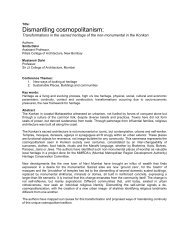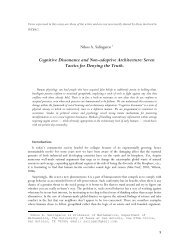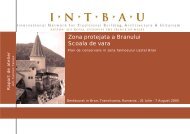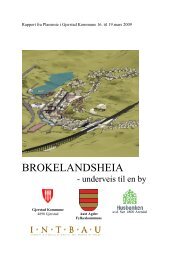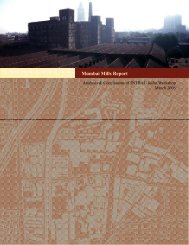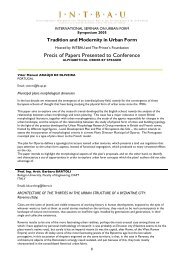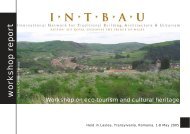Thematic Area 1: New ways of looking at heritage Sub ... - Intbau
Thematic Area 1: New ways of looking at heritage Sub ... - Intbau
Thematic Area 1: New ways of looking at heritage Sub ... - Intbau
Create successful ePaper yourself
Turn your PDF publications into a flip-book with our unique Google optimized e-Paper software.
<strong>of</strong> architecture and planning are from 1 to 30 having 2626 verses. However, the parameterslisted above appear in more than one area in the volumes. For example, rituals are describedin chapter 4; Taking possession <strong>of</strong> site, chapter 8; Offerings, chapter 9; Village planning,chapter 12; The found<strong>at</strong>ion deposit, chapter 18; Making <strong>of</strong> ro<strong>of</strong> and completion <strong>of</strong> works,chapter 24; G<strong>at</strong>e<strong>ways</strong>, chapter 27; Fe<strong>at</strong>ures <strong>of</strong> houses for the 4 classes, chapter 28; First entryinto house.It was decided to select this book since it is a well structured book, complete with exhaustiveexplan<strong>at</strong>ory footnotes. An added advantage was th<strong>at</strong> it had both the Sanskrit text and Englishtransl<strong>at</strong>ion on adjacent pages (Sanskrit on the left page and English on the right one) so th<strong>at</strong>the words and their exact meanings could be easily identified.METHODOLOGY AND SCOPE:The process followed for the explor<strong>at</strong>ion <strong>of</strong> architecture as described in ‘Mayam<strong>at</strong>am’ isgiven in Table 2 below:Table 2: MethodologyStep 1 Studying a chapter; Reading the Sanskrit text and its English transl<strong>at</strong>ion.Step 2 Tabul<strong>at</strong>ing the word to word meaning <strong>of</strong> the Sanskrit text and English transl<strong>at</strong>ion.Step 3Step 4Step 5Step 6Step 7In this process, adding notes wherever an altern<strong>at</strong>ive interpret<strong>at</strong>ion is possible, orsome additional transl<strong>at</strong>ion is to be done.Based on the understanding, cross referencing and library survey (ASIpublic<strong>at</strong>ions, books by various authors), making first draft <strong>of</strong> the sketches on asquare grid sheet along-with comments. The interpret<strong>at</strong>ion is <strong>at</strong> two types, one issequential and other is an integr<strong>at</strong>ion th<strong>at</strong> is a figure made from inform<strong>at</strong>ionpresent in different places in the text.Making final sketches on a square grid sheet along-with comments and crossreferences.Preparing CAD drawings and Three dimensional CAD models <strong>of</strong> each sketch.Present<strong>at</strong>ion <strong>of</strong> d<strong>at</strong>a and findings in the form <strong>of</strong> sheets, models, tables, images,slides etc., depending on the purpose <strong>of</strong> the present<strong>at</strong>ion.The exercise <strong>of</strong> tabul<strong>at</strong>ion has been very helpful in a more in-depth understanding <strong>of</strong> the textas every technical term has become clear. Doing this on a computer also helps in finding thesame word and its different interpret<strong>at</strong>ions depending on its context in the ślokā. Generalwords have not been transl<strong>at</strong>ed and put into appropri<strong>at</strong>e cells in many cases by me.Explan<strong>at</strong>ion <strong>of</strong> Process followed with the help <strong>of</strong> examples:Steps 1 to 3:In Mayam<strong>at</strong>am the chapter 13 is titled ‘The Socle’ (Upapitha). The Socle is a building partwhich is placed bene<strong>at</strong>h the base (adhishthana) which acts as a supplementary base andmakes the building more high. The verses 6 to 8 describe a socle named ‘vedibhadra’ type 1.After studying and understanding the text, the word to word transl<strong>at</strong>ion is tabul<strong>at</strong>ed. Thetabul<strong>at</strong>ion alongwith comments are shown in Table 3. In chapter 15 ‘Dimensions <strong>of</strong> Pillarsand Choice <strong>of</strong> M<strong>at</strong>erials, in verse 29, the transl<strong>at</strong>ion <strong>of</strong> one phrase in the ślokā <strong>of</strong>fers analtern<strong>at</strong>ive interpret<strong>at</strong>ion. The details <strong>of</strong> the verse and the altern<strong>at</strong>ive interpret<strong>at</strong>ion are shownin Table 4.



